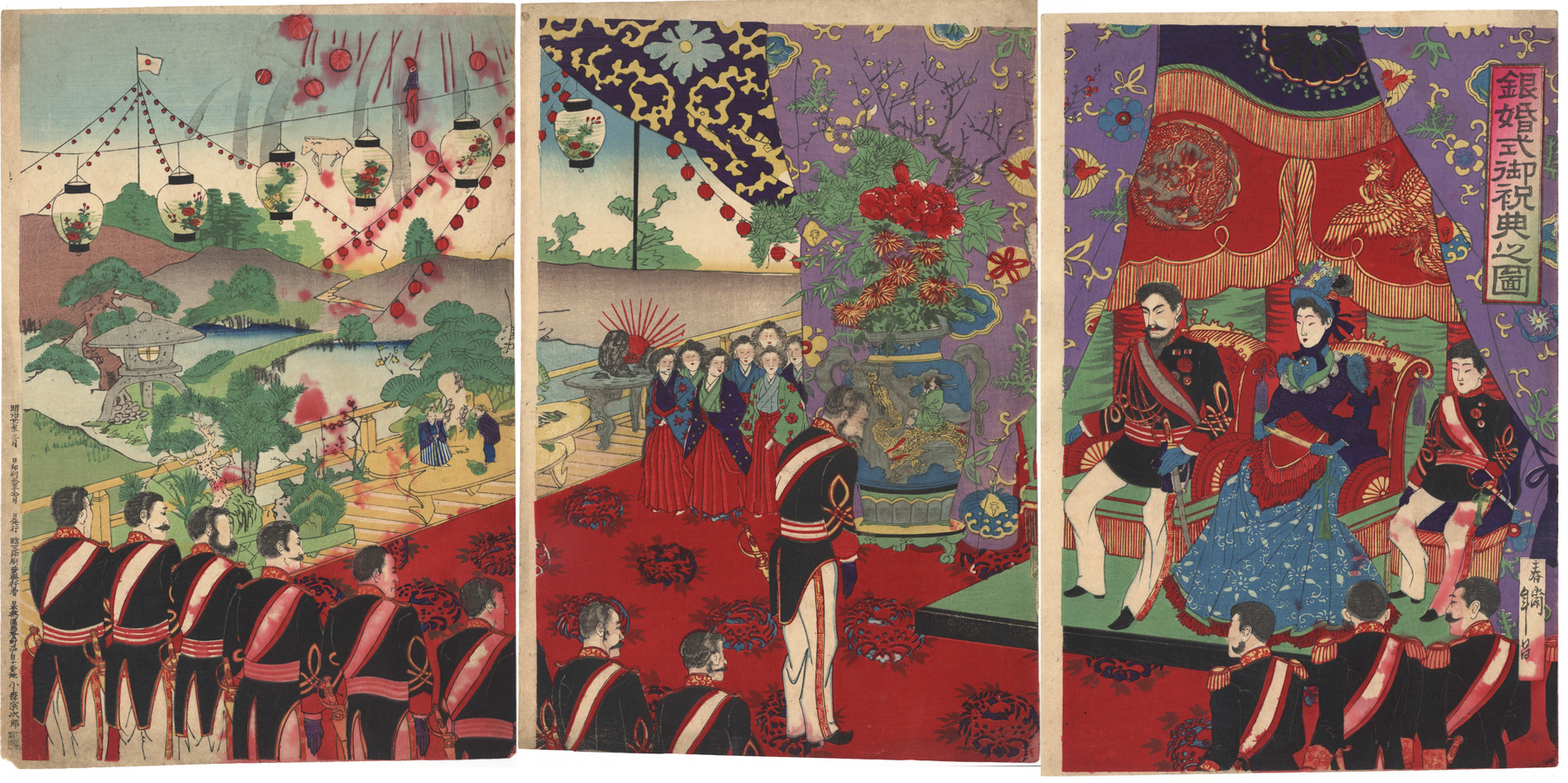About This Print
Source: The Dawn that Never Comes: Shimazaki Tōson and Japanese Nationalism, Michael Bourdaghs, Columbia University Press, 2010, p. 87.
A depiction of one of many ceremonies (as described below) that took place on the day of the silver wedding anniversary of the emperor and empress on March 9, 1894. In this print we see Emperor Meiji, Empress Haruko and the crown prince, the future Emperor Taisho, receiving felicitations from an official dressed in military attire. In discussing the re-definition of the family during the early Meiji years along more Western lines (e.g. monogamous marriage as a new norm), Professor Michael Bourdaghs writes:
[T]he new public ceremonies commemorating marriages and wedding anniversaries for the imperial family played a central role in propagating this new norm [monogamous marriage]. Such ceremonies were part of the nation-state's family discourse, 'in which the imperial household and the people were mystically bound together as a family." Despite the fact that the crown prince (the future Taisho Emperor) was the biological son not of the Meiji Empress, but of one of the Emperor's concubines, public ceremonies such as the 1894 Silver Wedding Anniversary provided the image of Emperor and Empress as a stable, monogamous married couple, a model for the nation, because "it was imperative that the family itself be a properly ordered model for the nation."
For another print of the Silver Anniversary see IHL Cat. #383 Illustration of the Celebration of the Silver Wedding Anniversary by Yōshū Chikanobu (1838-1912).
The Silver Wedding Anniversary of Emperor Meiji and Empress Shōken
Source: Emperor of Japan: Meiji and His World, 1852-1912, Donald Keene, Columbia University Press, 2002, p. 471.The wedding anniversaries of Japanese sovereigns had never before been a matter for public rejoicing, but when the emperor was informed that it was customary for royalty in foreign countries to celebrate “silver weddings,” he gladly gave his consent to the proposed celebrations. To make sure the proper tone for the celebration was maintained, a committee was formed to investigate foreign examples.
The Ceremonies
Source: Splendid Monarchy: Power and Pageantry in Modern Japan, T. Fujitani, University of California Press, 1998, p. 113-114.
The core ceremonies...began within the sacred and invisible confines of the Palace Sanctuary, continued into the public rooms of the palace where Japanese and foreign dignitaries observed them, and culminated with an imperial military review at the Aoyama Military Parade Field.
Before noon, the emperor, dressed in his formal military uniform (seiso), and the empress, dressed in a white Western gown, received the felicitations of Japanese and foreign dignitaries. These included over two hundred Japanese princes, peers, and high officials, both civil and military.
Also see the article Prints of Emperor Meiji, Empress Shōken and the Royal Family.
Print Details
| IHL Catalog | #2074 |
| Title or Description | Illustration of the Silver Wedding Celebration 銀婚式御祝典之図 |
| Artist | Utagawa (Shunsai) Toshimasa (1866-1913) |
| Signature |  |
| Seal | no artist's seal |
| Publication Date | 明治廿七年三月 March 1894 (Meiji 27) |
| Publisher | 臨写印刷兼発行者 日本橋区室町三丁目十番地 小森宗次郎 Komori Sōjirō (also Kiya Sōjirō 木屋宗次郎) [Marks: similar to seal ref. 26-146; pub. ref. 252] (click on image to enlarge) |
| Carver |  |
| Impression | excellent |
| Colors | good - bleeding into surrounding areas of red ink |
| Condition | good - irregular trimming of center sheet |
| Genre | ukiyo-e; kaika-e |
| Miscellaneous | |
| Format | vertical oban triptych |
| H x W Paper | 14 11/16 x 9 15/16 in. (37.3 x 25.2 cm) approx. each sheet |
| H x W Image | 14 3/16 x 9 3/8 in. (36 x 23.8 cm) approx. for each sheet |
| Literature | |
| Collections This Print |
1/17/2020 created


